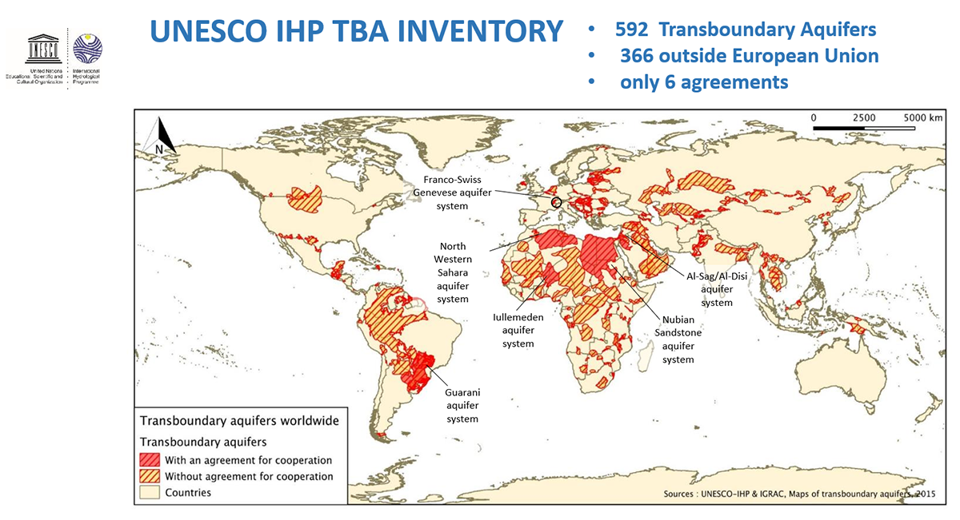CWM in Transboundary Context
This section was prepared in collaboration with UNESCO Category II Centre - International Groundwater Resources Assessment Centre (IGRAC).
Managing surface water and groundwater together under current frameworks is difficult as often, legal and regulatory frameworks are separate or have a bias towards surface water (van der Gun, 2020). Conjunctive Water Management is made even more challenging when applied within a transboundary context. When a river, lake or aquifer crosses a political or international border, it is considered to be transboundary and thus the resource is shared between one or more country/state.
Conjunctive management in transboundary existing water treaties and agreements
Conjunctive management of transboundary resources was brought to international attention due to its inclusion within the Sustainable Development Goal agenda in 2016. Target 6.5 of the SDGs specifically refers to achieving IWRM through transboundary cooperation and look in particular at the way groundwater is included in transboundary arrangements initially applicable within river basins (UNECE and UNESCO, 2018; UNESCO and UNECE, 2021).
A study by Lautze et al. (2018) found that 80% (209) water treaties globally were surface water orientated, 2% (5) were groundwater orientated and only 19% (52) were designed to manage both transboundary surface water and groundwater. However, of these 52 treaties, the majority of them were found to still have a heavy surface water component compared to their groundwater counterpart. There are 8 treaties that give a substantial focus to both surface and groundwater. It is however unclear whether these treaties that focus on both surface and groundwater actually promote conjunctive management and if they do, how many of these transboundary conjunctive management provisions are actually implemented on the ground.
Example of conjunctive water management in the field in transboundary context
Cases where transboundary conjunctive water management has actually been implemented in the field are scarce. Limited examples include freshwater banking in the Fergana Valley aquifers (Syr Darya Basin) to manage seasonal water supply fluctuations for irrigation (Karimov et al., 2010 in Lautze et al., 2018). Within Europe, transboundary conjunctive water management can be seen in the management of the Genevese Aquifer and hydraulically linked surface waters through managed (diverted) aquifer recharge in order to control reducing groundwater levels (Cobos, 2018; UNESCO, 2021).
Obstacles regarding conjunctive water management in transboundary context
The difficulties in managing a transboundary water resource are complex. These issues are exacerbated at a conjunctive management level. Considerations of water ownership, user rights and resource allocation must be agreed upon on a multi-national basis. Obstacles often include a lack of groundwater monitoring data in comparison to surface water data, cross-border data harmonization, limited financial resources, a poor understanding of hydraulic linkages between surface and groundwater and the lack of transboundary aquifer delineation within many river basins (van der Gun, 2020). Furthermore, there is often a lack of a mandate and capacity to push for conjunctive water management within a transboundary context. Currently established management mechanisms are also often surface water based and even with the inclusion of groundwater within their mandate, there is often a risk of uneven focus towards surface water. This is complicated by the fact that river and lake water basins often do not align with groundwater basin delineation. Compounding these issues are a lack of legal and institutional frameworks on to facilitate transboundary conjunctive water management.
Benefits of conjunctive water management in transboundary context
Although barriers exist, there are many potential benefits to be had through the conjunctive management of transboundary water.
- These include increasing water security (creating reliable sources of drinking water), forming drought buffers and flood mitigation, irrigation, climate resilience, protection of aquatic and terrestrial life, optimizing water productivity and environmental sustainability, salinity control, flood control and an increase in water quality (van der Gun, 2020).
- Specific tools for the implementation of these methods include managed aquifer recharge (MAR) (UNESCO, 2021), wastewater treatment, desalination, watershed management, conjunctive use of surface water and groundwater, groundwater level control in surface irrigated zones, restricted groundwater pumping to maintain environmental flows and the management of used and wastewaters.
- Another major opportunity for transboundary conjunctive water management is to reduce to the potential for water associated conflict that may be associated with transboundary pollution or a reduction in water levels flowing into downstream countries/states.

Institutional frameworks for transboundary conjunctive water management
Institutional frameworks for transboundary conjunctive water management are currently limited. Often, River Basin Organizations (RBOs) are tasked with facilitating the regional joint management of water resources within their extent. Enhancing the capacity of these transboundary basin organizations could encourage collaboration and coordination over transboundary management. RBOs are however often limited by a lack of a legal mandate for transboundary management and a strong traditional focus on surface water. In other to enhance conjunctive water management, a training manual on 'Integration of Groundwater Management into Transboundary Basin Organizations in Africa' is developed by several partners (AGW-Net et al., 2014).
An example of successful implementation of transboundary aquifer management with RBO structure is the groundwater hydrology committee set up within the Orange-Senqu River Commission (ORASECOM) that aims to facilitate a dialogue between the basin states on transboundary aquifer management (UNESCO, 2016; Nijsten, 2018). The establishment of this structure was promoted under the UNESCO Project “GGRETA – Governance of Transboundary Aquifers”, financed by the Swiss Agency for Development and Cooperation (SDC) (UNESCO, 2015). Another good example is from the DIKTAS (“Protection and Sustainable Use of the Dinaric Karst Transboundary Aquifer System”) project potentially (UNESCO, 2016). In all Dinaric project countries, Inter-ministerial Committees were organized, representing all national the ministries dealing with water. The Committees were then represented in the regional Coordination Body.
Legal mechanisms
Legal mechanisms for groundwater and for surface water management are often separate. However international legal frameworks for transboundary conjunctive management include:
- the UN draft articles on the Law of Transboundary Aquifers (UNILC, 2008)
- the UN 1997 Convention on the Non-Navigational Use of Watercourses (UN Watercourses Convention) (UNWC, 2014)
- the 1992 Convention on the Protection and Use of Transboundary Watercourses and International Lakes (Water Convention) (UNECE, 1992)
References
AGW-Net, BGR, IWMI, CapNet, ANBO, & IGRAC. 2014. Integration of Groundwater Management into Transboundary Basin Organizations in Africa. Training Manual. Available online at: https://www.gwp.org/globalassets/global/toolbox/references/trainingsmanual.pdf
Cobos, Gabriel de los, 2018. Transboundary aquifers: governance of groundwater resources, promoting multi-country mechanisms for the governance of transboundary aquifers; a success story of cooperation for the management of transboundary aquifers at local level: the Genevois Aquifer (Switzerland-France). Available online at: https://unesdoc.unesco.org/ark:/48223/pf0000265906?posInSet=5&queryId=e03b724e-a9a6-4f83-9e66-eb6ab736a57f
International Groundwater Resources Assessment Centre (IGRAC) website: https://www.un-igrac.org/
ISARM. 2021. 2nd International Conference: Transboundary aquifers: challenges and the way forward; book of abstracts. Available online at: https://unesdoc.unesco.org/ark:/48223/pf0000380029?posInSet=7&queryId=fab82c25-e998-4e91-a38a-5e69ecce6759
IWMI, & SADC-GMI. 2018. Transboundary Diagnostic Analysis for the Shire River-Aquifer System. Report. Available online at: https://sadc-gmi.org/wp-content/uploads/2020/05/ENG_ShireConWat-SAP-1-2.pdf
Karimov, A., Smakhtin, V., Mavlonov, A. & Gracheva, I. 2010. Water banking in Fergana valley aquifers: a solution to water allocation in the Syrdarya river basin? Agricultural Water Management 97(10), 1461–1468.
Lautze, J., Holmatov, B., Saruchera, D., Villholth, K.G. 2018. Conjunctive management of surface and groundwater in transboundary watercourses: a first assessment. Water Policy. 20 (1): 1-20. https://doi.org/10.2166/wp.2018.033
Nijsten, G-J., Christelic, G., Villholth, K.G., Braune, E., Becaye Gaye, C. 2018. Transboundary aquifers of Africa: Review of the current state of knowledge and progress towards sustainable development and management. Journal of Hydrology: Regional Studies. Volume 20, December 2018, Pages 21-34. https://doi.org/10.1016/j.ejrh.2018.03.004
UNESCO. 2016. Stampriet Transboundary Aquifer System Assessment: governance of Groundwater resources in Transboundary Aquifers (GGRETA), phase 1: technical report. Available online at: https://unesdoc.unesco.org/ark:/48223/pf0000245265?posInSet=1&queryId=673423a1-3bfc-4724-a25d-2a26f0fed3fc
UNILC. 2008. Draft articles on the Law of Transboundary Aquifers. Available online at: https://legal.un.org/ilc/texts/instruments/english/draft_articles/8_5_2008.pdf
UNECE. 1992. Convention on the Protection and Use of Transboundary Watercourses and International Lakes (Water Convention). Available online at: https://www.unece.org/env/water
UNECE and UNESCO. 2018. Progress on Transboundary Water Cooperation. Global baseline for SDG indicator 6.5.2. Report. Available online at: https://www.unwater.org/publications/progress-on-transboundary-water-cooperation-652/
UNESCO, GEF, UNDP. 2016. DIKTAS: Protection and Sustainable Use of the Dinaric Karst Aquifer System. Available online at: https://unesdoc.unesco.org/ark:/48223/pf0000245192?posInSet=1&queryId=df291d1b-f5c2-49d0-9bbe-9bdfdcc74f72
UNESCO. 2021. Managing aquifer recharge: a showcase for resilience and sustainability. Available online at: https://unesdoc.unesco.org/ark:/48223/pf0000379962?posInSet=6&queryId=7f4d663a-c8cc-42a1-ac8e-9c2a9e54b2a9
UNESCO. 2015. Governance of groundwater resources in transboundary aquifers (GGRETA) project: overview and results of the assessment phase (2013-2015). Available online at: https://unesdoc.unesco.org/ark:/48223/pf0000243003?posInSet=2&queryId=a7256bb8-45b8-49fd-a3de-fc8722bc59cd
UNWC. 2014. Convention on the Law of the Non-navigational Uses of International Watercourses 1997. Available online at: https://unece.org/environment-policy/water/un-watercourses-convention
van der Gun, J. 2020. Conjunctive Water Management. A powerful contribution to achieving the Sustainable Development Goals. United National Educational, Scientific and Cultural Organization. Available online at: https://iwlearn.net/resolveuid/e78ccb09-dcb2-4952-86cc-b64c98657da0


